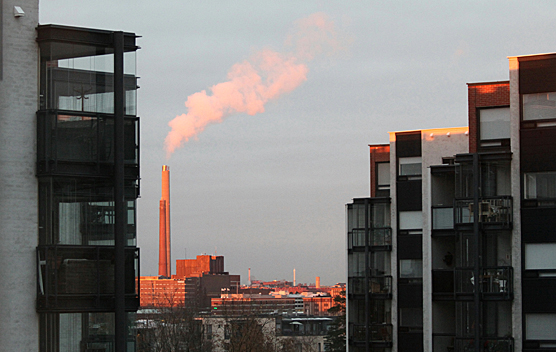
© Olli-Pekka Pietiläinen
Climate emissions have decreased in nearly all Finnish municipalities since 2005. The average decrease is 15 per cent. The reduction in municipal emissions has been driven by the decline in electricity emissions, reforms in district heating production and the construction of wind power. Emissions from oil-fired heating have dropped at a relatively similar pace in all municipalities, resulting in a significant impact at the national level.
There are big differences in emissions reductions between municipalities. The largest reductions from 2005 exceed 50 per cent. In contrast, some municipalities have recorded an increase in their emissions.
The Finnish Environment Institute has calculated the volume and trend in climate emissions for all Finnish municipalities from 2005 to 2017. This was the first time that a new, uniform calculation method was used to determine all municipal emissions. The results will be updated annually from now on.
“This internationally unique calculation system enables the emissions data of individual municipalities to be analysed to satisfy the needs of both the EU and the municipalities. This provides brand new opportunities to support local climate work and monitor the impact of various steering methods all around Finland,” says Professor Jyri Seppälä from the Finnish Environment Institute.
According to the new emissions calculations, the main sources of emissions in Finnish municipalities include road transport (25%), agriculture (17%), district heating (17%) and electricity consumption (heating and other consumer electricity 13%).
Notable regional differences
Emissions per resident vary considerably in different municipalities, ranging from some 3 tonnes to over 25 tonnes of carbon dioxide equivalent. On average, the municipal emissions per resident totalled 10.7 tonnes in 2017.
There are also great regional differences in the volume of emissions. For example, in the Uusimaa region, emissions from passenger cars, calculated per resident, have decreased by 21 per cent since 2005, while in Lapland, Kainuu, North Savo and South Savo, the equivalent decrease amounts to 12 per cent. Emissions from passenger cars vary depending on the number of vehicles registered in the municipalities and regions, the emission factors of vehicles and the distances driven. In the Uusimaa region, passenger cars are clearly newer and generate lower emissions compared to other regions.
The trend regarding emissions from district heating shows considerable regional fluctuation. In Ostrobothnia, South Karelia and North Karelia, district-heating emissions per resident have decreased by more than 40 per cent. In South and Central Ostrobothnia, in turn, emissions have increased. The replacement of fossil fuels by biofuels and waste, the utilisation of waste heat and the introduction of heat pumps have contributed to reduced emissions. In some municipalities, the choice of fuel used in district heating may have led to an increase in emissions.
“The new calculations help municipalities assess their emissions in greater detail and more effectively target measures to curb climate change and reach climate targets,” says Johannes Lounasheimo, Senior Specialist at the Finnish Environment Institute.
“We need a reliable, transparent and jointly approved model for monitoring the emissions development in municipalities. It is also important to keep in mind that municipalities differ greatly from one another in terms of, for example, their geographical location and business structure,” Lounasheimo adds.
“The emissions calculations provided by the Finnish Environment Institute strongly steer climate work in Porvoo and other municipalities, and it is important that we have nationally comparable data available. It will be interesting to analyse the results in greater detail,” says Sanna Päivärinta, Sustainable Development Expert, City of Porvoo.
Increasingly accurate estimate of the sources of emissions
The new emissions calculation system encompasses all emissions in the Finnish greenhouse gas inventory, with the exception of industrial process emissions and the land use sector. The emissions have been allocated to the effort sharing and emissions trading sectors, and the sectoral division follows that used in previous municipal calculations: electricity consumption, heating of buildings, transport, industry, work machinery, agriculture and waste treatment. Each emissions category can now be analysed in greater depth. For example, regarding energy consumption, analyses can focus solely on residential emissions, if required. The new system also treats fluorinated greenhouse gases as emissions.
In addition to providing calculations based on all emissions, the results are also presented in accordance with HINKU calculation rules. Used to monitor the targets of municipalities, HINKU calculations exclude factors that the municipalities are unable to influence. HINKU calculations do not take into account industrial fuel use, which is included in emissions trading. All industrial electricity consumption as well as waste emissions are also excluded from HINKU calculations. Road transport is assessed using the new calculation model, without pass-through traffic. Municipalities are awarded carbon credits for wind power produced in their area. All the main results presented here comply with the HINKU calculation rules.
Several sources of emissions can now be assessed in greater detail than before. For example, emissions from electric heating are calculated more accurately at a monthly level. Calculations focused on individual heating solutions, work machinery as well as water and rail transport have also been developed.
The biggest reform focuses on road transport, where the measures of municipalities and their residents are taken better into account when calculating emissions. Passenger car calculations are based on the vehicles registered in the municipality and the distances driven with them, irrespective of municipal borders. Regional emissions and emissions from pass-through traffic are calculated separately for lorries, buses and vans.
The municipal emissions calculation system has received funding from the Ministry of the Environment (ALas project) and the Life IP Canemure project. The calculation system will be further developed and updated in the Finnish Environment Institute’s future projects.
All the results are openly available.
Read more
Further information
- Professor Jyri Seppälä, leader of the HINKU network, Finnish Environment Institute, tel. +358 29 525 1629, firstname.lastname@ymparisto.fi
- Johannes Lounasheimo, Senior Specialist, Finnish Environment Institute, tel. +358 29 525 1963, firstname.lastname@ymparisto.fi
- Santtu Karhinen, Researcher, Finnish Environment Institute, tel. +358 29 525 1889, firstname.lastname@ymparisto.fi